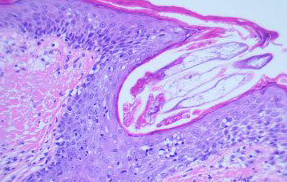Ryme Dassouli1*, Hanane BayBay1, Imane Kacimi1, Sara Elloudi1, Zakia Douhi1, Fatima Zahra Mernissi1
1Department of Dermatology, University Hassan II, Morocco
*Corresponding Author: Ryme Dassouli, Department of Dermatology, University Hassan II, Morocco;
E-mail: [email protected]
Published Date: 29-04-2022
Copyright© 2022 by Dassouli R, et al. All rights reserved. This is an open access article distributed under the terms of the Creative Commons Attribution License, which permits unrestricted use, distribution, and reproduction in any medium, provided the original author and source are credited.
Editorial
Demodecidosis is an opportunistic cutaneous ectoparasitosis, common to humans and many mammals, caused by the proliferation of Demodex in the pilosebaceous apparatus. This obligate saprophyte of the skin, ostia-pilosebaceous of seborrheic areas, can become pathogenic in case of cosmetic abuse and debilitated terrain or altered immune status [1] . We report a case of facial demodecia revealing an infection by the human immunodeficiency virus.
A 34 years old man with a history of multiple sexual relationships, presented with a pruritic maculo- papular rash of the face that had been evolving for 5 months, unimproved by the application of fusidic acid and exacerbated by dermocorticoids. Clinical examination revealed a pruritic and oedematous erythematous patch on both cheekbones, forehead and chin associated with pustular lesions (Fig. 1). Dermoscopic analysis identified whitish filiform structures corresponding to the Demodex parasite attached to the skin (Fig. 2). The histopathological study confirmed the diagnosis (Fig. 3). The blood count showed a lymphopenia of 520/mm3 with normal eosinophils. HIV serology came back positive (CD4 lymphocytes=120/mm3). The patient noted an improvement under oral erythromycin and local ketokonazole with attenuation of the infiltration and disappearance of pruritus.
Demodicidosis is a facial dermatosis due to Demodex proliferation. Two clinical variants, primary and secondary, can be observed. Secondary DD occurs most often in highly immunocompromised patients, such as those with leukemia and HIV infection, as well as those treated with immunosuppressive drugs [2]. It accounts for 5% of folliculitis in HIV-infected individuals [2]. In fact, the dermatosis occurs during severe immunodepression (CD4 lymphocytes<200/mm3) [3,4]. It can then be more profuse and reach the trunk and the upper limb [4]. In the event of a persistent, treatment-resistant picture, it is necessary to consider a DD secondary to HIV.
The clinical aspect is polymorphic: a telangiectatic erythema of the face (cheeks, nose, forehead and chin) complicated by papulo-pustular outbreaks. This aspect sometimes makes it difficult to distinguish from other facial dermatoses, particularly rosacea [3].
The diagnosis of demodecia is made when the clinical picture is suggestive, when there are numerous parasites on direct examination and when there is a clinical response to acaricide treatment [4].
Although the clinical symptoms of demodecidosis are often unrecognized, Demodex captured by “standardized skin surface biopsy” from their sequestration in the deep follicular canal have clinical significance in triggering inflammation. Preliminary studies using new diagnostic techniques such as dematoscopy. Our observation shows the interest of demoscopy in the diagnosis [2-5]. It allows visualization of gelatinous filaments protruding from follicular openings, called “Demodex tails” corresponding to the mite itself. Dilated follicular openings containing round, grayish/pale brown plugs surrounded by an erythematous halo. These are two specific features of DD [6].
General treatment with MNZ was of choice, with duration and regression conditioned by clinical findings. Erythromycin associated at once or in case of failure seems to improve the picture. The association with a local treatment (Crotamiton or ketokonazole) gave good results as shown by our observation. In front of a red rosaceiform face not responding to the usual treatments, it is necessary to think of an immune deficiency among others an HIV infection.

Figure 1: An oedematous erythematous patch on both cheekbones, forehead and chin associated with pustular lesions.

Figure 2: A face dermoscopy showing whitish dots whitish filiform structures protruding out of follicular openings, representing demodex tails.

Figure 3: A Skin biopsy showed Demodex within a dilated follicular infindibulum (Hematoxylin and eosin stain).
Keywords
Demodicidosis; HIV; Dermoscopy; Erythromycin
Consent
The examination of the patient was conducted according to the principles of the Declaration of Helsinki. The authors certify that they have obtained all appropriate patient consent forms, in which the patients gave their consent for images and other clinical information to be included in the journal. The patients understand that their names and initials will not be published and due effort will be made to conceal their identity, but that anonymity cannot be guaranteed.
Conflict of Interest
The authors declare that they have no conflict of interest.
References
- Bouattour Y, Rekik F, Jallouli M, Garbaa S, Turki C, Frikha F, et al. Démodécidose faciale mimant une poussée d’un lupus érythémateux systémique. La Revue de Médecine Interne. 2016;37:A243.
- Chen W, Plewig G. Human demodicosis: revisit and a proposed classification. Br J Dermatol. 2014;170:1219-25.
- Olivares, Julio César Jasso, Cherit, Judith Domínguez, Tomoka, María Teresa Hojyo, et al. Demodecidosis: una revisión clínica y terapéutica. Dermatología Cosmética, Médica Y Quirúrgica. 2014;12:122-7.
- Malakar S, Mahesh AR. Can demodex incite pseudolymphoma? A dermoscopic revelation. Our Dermatol Online. 2020;11(2):204-5.
- Errichetti E, Stinco G. Dermoscopy in general dermatology: a practical overview. Dermatol Ther (Heidelb). 2016;6:471-507.
- Friedman P, Sabban EC, Cabo H. Usefulness of dermoscopy in the diagnosis and monitoring treatment of demodicidosis. Dermatol Pract Concept. 2017;7:35-8.
Article Type
Editorial
Publication History
Received Date: 09-04-2022
Accepted Date: 22-04-2022
Published Date: 29-04-2022
Copyright© 2022 by Dassouli R, et al. All rights reserved. This is an open access article distributed under the terms of the Creative Commons Attribution License, which permits unrestricted use, distribution, and reproduction in any medium, provided the original author and source are credited.
Citation: Dassouli R, et al. Facial Demodicidosis Revealing HIV. J Dermatol Res. 2022;3(1):1-5.

Figure 1: An oedematous erythematous patch on both cheekbones, forehead and chin associated with pustular lesions.

Figure 2: A face dermoscopy showing whitish dots whitish filiform structures protruding out of follicular openings, representing demodex tails.

Figure 3: A Skin biopsy showed Demodex within a dilated follicular infindibulum (Hematoxylin and eosin stain).


